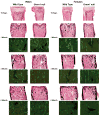Gremlin1 is required for skeletal development and postnatal skeletal homeostasis
- PMID: 21412775
- PMCID: PMC3132213
- DOI: 10.1002/jcp.22730
Gremlin1 is required for skeletal development and postnatal skeletal homeostasis
Abstract
Gremlin is an antagonist of bone morphogenetic proteins, and its overexpression causes suppressed osteoblastogenesis and osteopenia. Inactivation of Grem1 results in severe developmental defects, but the consequences of the global inactivation of Grem1 on the postnatal skeleton are not known. To study the function of gremlin, Grem1 was inactivated by homologous recombination, and mice were maintained in a C57BL/6/FVB mixed genetic background due to embryonic and neonatal lethality in the uniform C57BL/6 background. Grem1 null mice exhibited developmental skeletal abnormalities, leading to incomplete formation of metatarsal bones and of fore limbs and hind limbs. Grem1 null mice exhibited decreased weight and body fat and shortened femoral length. Bone histomorphometric and microarchitectural analyses of distal femurs revealed decreased bone volume and increased bone formation in 1-month-old Grem1 null mice. Trabecular femoral bone volume was restored in older Grem1 null female mice, and to a lesser extent in male mice. Vertebral microarchitecture confirmed the osteopenia observed in 1-month-old Grem1 null mice and demonstrated recovery of trabecular bone in older female, but not in older male Grem1 null mice, which exhibited persistent vertebral osteopenia. In conclusion, Grem1 is not only necessary for skeletal development, but also for postnatal skeletal homeostasis; its inactivation causes osteopenia, which is partially reversed in a spatial, temporal, and sex-dependent manner due to an increase in bone formation.
Copyright © 2011 Wiley Periodicals, Inc.
Figures




References
-
- Bouxsein ML, Boyd SK, Christiansen BA, Guldberg RE, Jepsen KJ, Muller R. Guidelines for assessment of bone microstructure in rodents using micro-computed tomography. J Bone Miner Res. 2010;25:1468–1486. - PubMed
-
- Brigstock DR. The CCN family: a new stimulus package. J Endocrinol. 2003;178:169–175. - PubMed
-
- Canalis E, Economides AN, Gazzerro E. Bone morphogenetic proteins, their antagonists, and the skeleton. Endocr Rev. 2003;24:218–235. - PubMed
Publication types
MeSH terms
Substances
Grants and funding
LinkOut - more resources
Full Text Sources
Other Literature Sources
Molecular Biology Databases

